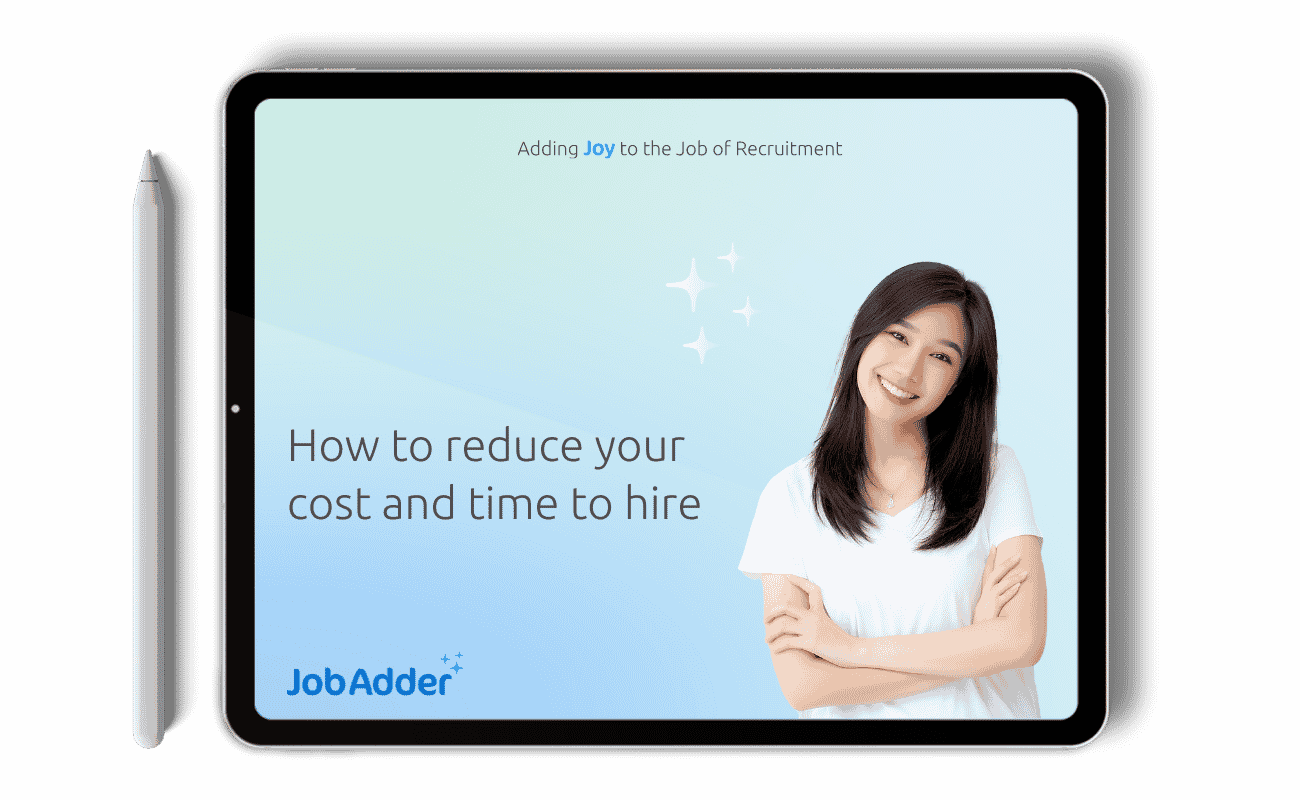Recruitment Blog
Creating an effective recruitment process: Key benefits and tips for success

It can be difficult to find and recruit the right candidate for an open position. From putting together the perfect job ad to sifting through applications and interviewing for an open role, recruitment is a time-consuming and expensive process for many companies. Hiring managers and talent acquisition professionals need a solid hiring and recruitment process to streamline the process and effectively fill open roles.
A successful recruitment process will allow you to save time and money throughout the hiring process and ensure all of your hiring needs are being met. Additionally, an effective recruitment process may allow you to cut down on employee turnover, which creates a more stable work environment.
FREE PLAYBOOK: 5 tips to improve collaboration between your team and hiring managers
What makes a recruitment process successful?
A good recruitment process allows businesses to find qualified candidates quickly and efficiently. This process starts at the beginning of the job search and does not end until a new employee is fully acclimated to their new role.
While it may seem daunting, there are a few ways that talent acquisition professionals and in-house recruiters can create a successful and effective process. And it’s definitely worth the effort, as an effective recruitment process can lower hiring costs, improve the quality of hire and increase overall productivity. Three big reasons to reassess and reform your recruitment process.
To start, one of the key ways that you can improve your recruitment process is by increasing automation at every step of the hiring journey. This allows you to free up time and seamlessly recruit top talent for your open roles.
Before we get into all that, let’s recap the big benefits you could see from implementing and nurturing an effective recruitment process at your company.
Benefits of an effective recruitment process
There are several benefits for in-house recruiters to utilise an effective recruitment process. An effective recruitment process helps you to:
- Save time: An effective recruitment process allows hiring managers and recruiters to avoid a long, complex application process. When relying on things like an Applicant Tracking System (ATS), recruiters can focus on their day-to-day tasks and spend their time on more important things.
- Become more proactive: A simplified and successful recruitment process is also designed to be more proactive when it comes to making hiring decisions. When tracking data properly, you can easily identify gaps ahead of time and reduce time to hire overall.
- Increase quality of hire: When you’re using a comprehensive and effective recruitment strategy, you’ll be able to improve the quality of your new hires. You can dedicate more time to talent acquisition and curate a unique talent pool to fill individual vacancies. You can also easily have a wider pool of talent to choose from, ensuring you have your pick of top talent.
- Reduce overall hiring costs: An automated but comprehensive recruitment process provides you with top-quality candidates from the get-go. This shortens your recruitment process, allowing you to spend less time at each stage. In turn, you’ll save on most of the costs associated with new talent acquisition.
FREE EBOOK: How to reduce your cost and time to hire
8 necessary recruitment process steps for your hiring team
As detailed above, an effective recruitment process is beneficial for acquiring top talent and improving overall company productivity. You don’t want to spend time and money sifting through thousands of applications and ending up with no new hires. You also don’t want to realise halfway through onboarding that your new hire is not a suitable fit for the company.
To reduce the chances of wasting time and money and recruiting the wrong people, you need to optimise your recruitment process. Think beyond just placing job ads and finding a person with the right academic qualifications.
Here are eight necessary recruitment steps your hiring team needs to take to ensure they optimise the hiring process and get the most suitable talent available:
1. Identify your individual needs
All hiring teams have a variety of different needs that need to be filled with each individual position. These needs may change based on whether or not you’re creating a new job or filling an open position.
Your needs will also impact the speed at which you need to fill a job opening and how advanced the role is. Finding a candidate with specific competencies may be more time-consuming than filling an entry-level role. On the other hand, finding the ideal candidate for a new entry-level role can take more time than filling a vacancy for an established mid-senior-level position.
Take time to review what your company needs and have these needs written down for the next step of the recruitment process.
2. Write and review the job description
The job description will be your candidate’s first impression of the role they’re applying for and your company. Many candidates will see hundreds of different job postings throughout their job search, so it’s important to ensure that yours stands out.
Some people may use a template for their job description, but it’s always best to customise it to suit the role you’re trying to fill and your company culture. A good job description is comprehensive, outlines role responsibilities well and provides insight into your employer brand.
Use your individual and industry-specific needs to customise the job description. The better your job description is, the more likely you are to attract some of the best candidates.
3. Create a recruitment plan with your hiring team
After creating the job description, you should outline clear expectations with your hiring team and create a detailed recruitment plan. Discuss who will be reviewing resumes and job applications, conducting job interviews and performing phone screenings.
It’s crucial for your entire team to be on the same page to remain organised, collect the information you need from candidates and reduce the time to hire. When everyone understands their role, they can better prepare themselves to do it. In turn, the entire process goes by faster because there are no unnecessary redundancies or setbacks.
4. Start searching for potential candidates
Getting the right candidate starts at this step in the recruitment process. Even before screening and interviews, scanning applications for the best candidate is where hiring begins. This can be a time-consuming task for even the most well-staffed hiring team.
Trying to crosspost to multiple job boards and track and compare all applications that come through can take weeks. You can also miss the right candidates and you’ll have to restart the entire process once interviewing is done and you don’t find your ideal candidate.
And this is where an Applicant Tracking System (ATS) comes in handy. With software like JobAdder, you can crosspost to multiple job boards at the same time and manage and review them all in one platform. You can also automate the screening of applications and do AI and skill matching searches of both the applications you’ve received and the existing candidates in your database.
Additionally, you can use an employee referral program to encourage your current employees to refer quality candidates within their network. A wider candidate pool means higher chances of finding top talent. You can use social media sites like LinkedIn to conduct some proactive sourcing to expand your candidate pool and overall reach.
5. Conduct phone screenings
Phone screenings are a great way to quickly screen candidates before inviting them in for an in-person interview. Create a shortlist of interview questions to ask via the phone before you get started with this process. The questions you choose should be relevant to the open role but also general enough to screen for other incompatibilities.
If your company has the capabilities, you can also use video screening to create a better candidate experience – this will often feel more personal and allow the interviewer to create a more genuine connection with the candidate. Video screening is especially important for remote roles as candidates will likely never step foot in the office for your hiring team to get a feel of them.
6. Begin the interview process
The interview process is one of the most crucial steps of the recruitment process. This is when you can get to know your candidates in person and determine if they’re a good fit for the role.
It’s important to keep in mind that your interviewee will be looking for a positive candidate experience as well. They’ll need to decide if they’re a good fit for your company’s culture before considering a job offer. The interview goes both ways so you’ll want your hiring team to also bring their best and most professional selves to the interview.
When you begin to conduct interviews, you’ll want to ensure you’re asking the right interview questions. The candidate you choose to hire may never have to work directly with the hiring team. However, they will spend every day directly in contact with certain employees in the relevant department. Involving any current employees that will work with this potential candidate is crucial to a successful interview process and a smooth integration into the company.
After the first round of interviews is complete, you can create a candidate shortlist and continue with second or third interviews as necessary. Please remember that a consolidated interview process is always best, so conduct group interviews where appropriate and don’t get your candidates to jump through unnecessary hoops.
7. Send out a job offer
Once you’ve found the right candidate, it’s time to send out a job offer. However, you should always be prepared in case your candidate doesn’t choose to accept your offer. Have your top four options clearly outlined so you can reach out to them if your first pick doesn’t accept.
You should also be prepared to negotiate salary and benefits with your potential candidate. It’s crucial to remember that it’s always worth fighting for the best possible candidate. You don’t want to settle for someone less qualified just because they may be more expensive.
It’s also good to keep in mind that transparency throughout the hiring process will lead to more accepted job offers. Job seekers like to feel comfortable and in the know throughout the recruitment process, so ensure communication is clear and consistent.
Don’t try to hide any possible company shortcomings or give lowball offers. In the age of social media and salary transparency, always assume your top candidate has done their homework and is ready to walk at the first sign of dishonesty on your end.
8. Begin new employee onboarding
The employee onboarding process is still an important part of recruitment. It’s the recruitment step that many companies neglect, which can often lead to a high turnover rate. Even though you have selected a candidate and had a job offer accepted, your hire will still need time to acclimate to a new role, team and environment.
During the onboarding process, you may perform things like background checks, discuss start dates, outline specific expectations and provide them with info on work hours, office etiquette and work attire.
You’ll also clearly outline what you expect the new hire to do on a day-to-day basis, as well as who they’ll regularly work with. Be clear on organisation structure, policies and guidelines. The point is to ensure that the new hire is confident in their new role and the company culture.
A solidified onboarding process will often lead to your team members quickly and seamlessly integrating into the company and may even lead to a higher employee retention rate.
Start optimising your recruitment process with JobAdder
The recruitment process is an integral part of hiring. It can allow you to reduce costs, increase productivity and place quality candidates in the right job positions. However, it’s not easy for your hiring team to optimise the recruitment process on their own.
Automation and tracking tools help your hiring team to simplify and streamline the recruitment process. Such tools do most of the heavy lifting for your hiring team, allowing them to focus on interviewing the right candidates and creating a great onboarding program. The best tool you can use to optimise your recruitment process is JobAdder (we may be biased, so here’s some proof to back us up).
JobAdder helps you search, engage and hire top talent for every job opening in your company. It’s a superior Applicant Tracking System and recruitment CRM that helps your hiring team to streamline hiring, stay organised and create an effective recruitment process.
With JobAdder’s powerful Applicant Tracking, you don’t have to go through every application, just the ones that have your carefully selected key terms and qualifications.
With the JobAdder Academy, your hiring team will receive in-app product training, helpful certification courses and an extensive library of videos and articles to guide their progress to ensure they stay on top of their recruitment game.
Request a personalised demo of JobAdder today and experience the benefits of a streamlined and effective recruitment process.
Ready to cut your cost and time to hire? Discover our top tips.

Related blog posts

To excel in the competition for top talent, proactive workforce planning is essential. Traditional methods struggle to adapt to evolving …
Ready to get started?
Talk to one of our friendly team members



